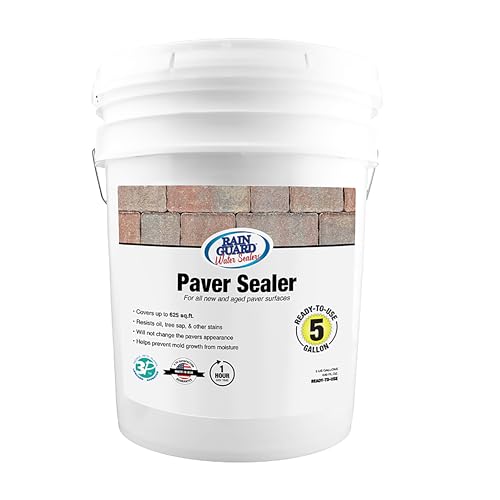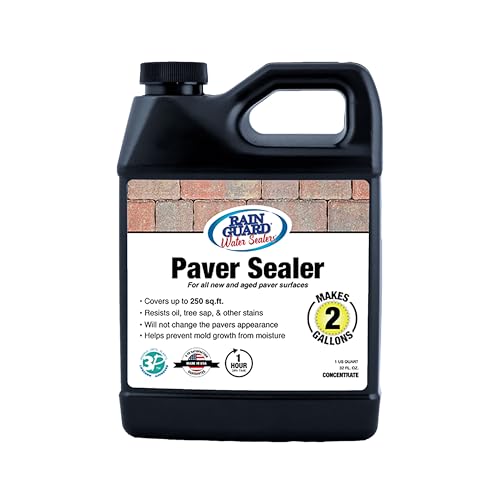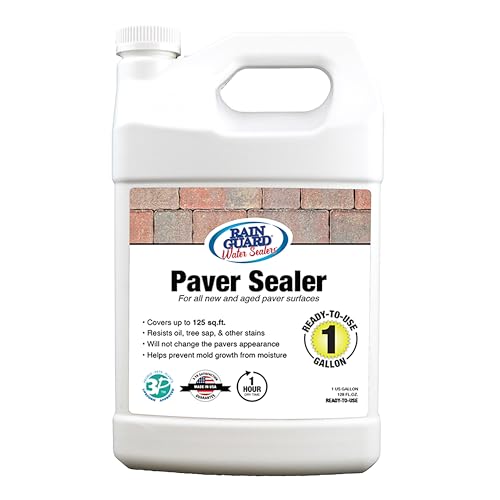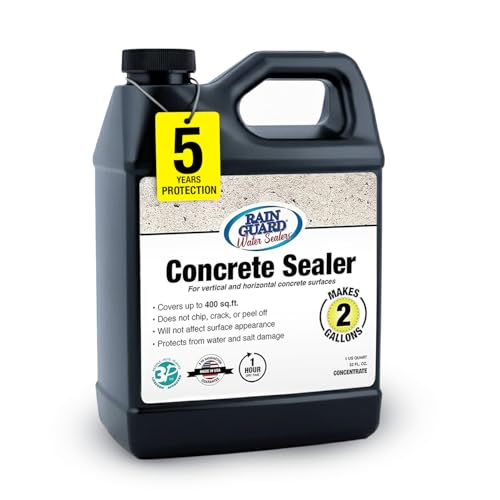So, you’ve invested in a beautiful paver patio or driveway, but have you thought about how often you should reseal it to maintain its charm? Pavers can add a touch of elegance to any outdoor space, but they do require some upkeep to stay looking their best. In our article, we’ll explore the importance of regular resealing for pavers and provide you with some helpful tips on the ideal frequency for this maintenance task.

Maintaining your pavers’ appearance and durability is crucial to ensure they stand the test of time. Whether you’re a seasoned homeowner or new to the world of paver maintenance, understanding the resealing process is key to preserving your investment. Join us as we delve into the world of paver care and learn how you can keep your outdoor surfaces looking fresh and inviting with the right resealing schedule.
Importance of Sealing Pavers
As landscape designers, we understand the crucial role that sealing pavers plays in preserving the beauty and longevity of outdoor spaces like patios and driveways. Let’s delve into why regular resealing is essential for maintaining the allure of these paved surfaces.
Protection From The Elements
Sealing pavers acts as a shield against the harsh impact of weather elements such as rain, snow, and UV rays. By creating a protective barrier, sealants help prevent moisture intrusion, which can cause cracks and erosion over time. This protection not only enhances the aesthetics of the pavers but also extends their lifespan, ensuring that your outdoor space remains a welcoming retreat for years to come.
Preventing Stains and Discoloration
Unsealed pavers are vulnerable to stains from oil spills, dirt, leaves, and other debris. These stains not only detract from the visual appeal of the paved area but can also be challenging to remove entirely. Sealing the pavers helps in repelling stains and reducing the risk of discoloration, keeping the surface looking fresh and vibrant. Additionally, sealants inhibit weed growth between the pavers, maintaining a cleaner and more polished appearance for your outdoor space.
Factors That Determine Resealing Frequency
Type of Pavers
When it comes to resealing pavers, the type of pavers you have plays a significant role in determining the frequency of resealing. Different types of pavers, such as concrete, brick, or stone, have varying levels of porosity and durability. For example, concrete pavers are more porous and may require resealing every 2-3 years to maintain their appearance and structural integrity. On the other hand, brick pavers are typically denser and may only need resealing every 4-5 years. Understanding the specific characteristics of your pavers will help us recommend the optimal resealing schedule to keep them looking their best.
Climate and Exposure
Another crucial factor in determining the resealing frequency of pavers is the climate and exposure to weather elements. Pavers that are exposed to harsh sunlight, heavy rain, or extreme temperature fluctuations may require more frequent resealing to protect them from damage and deterioration. In areas with high humidity or frequent precipitation, pavers are more susceptible to mold, mildew, and staining, necessitating more frequent resealing to maintain their appearance. By considering the climate and environmental factors that your pavers are exposed to, we can tailor a resealing schedule that ensures maximum protection and longevity.
Traffic and Usage
The level of traffic and usage that your pavers endure also influences how often they should be resealed. Pavers in high-traffic areas such as driveways, walkways, or commercial spaces experience more wear and tear, which can expedite the breakdown of the sealer. Regular foot traffic, vehicle traffic, or heavy equipment can cause the sealer to wear off more quickly, requiring more frequent resealing to preserve the pavers’ integrity. By assessing the specific usage patterns of your outdoor space, we can recommend a resealing frequency that aligns with the maintenance needs of your pavers and ensures lasting beauty and functionality.
Signs That Your Pavers Need Resealing
Fading and Weathering
When we inspect your outdoor pavers and notice significant fading or weathering, it’s a clear sign that they need resealing. Exposure to sunlight, rain, and other weather elements can gradually diminish the vibrancy of your pavers’ colors over time. If you observe a dull or washed-out appearance compared to when they were first installed, it’s an indicator that a fresh coat of sealer is needed to revive their look and protect them from further damage.
Erosion and Sand Loss
Another telltale sign that resealing your pavers is essential is erosion and sand loss between the joints. Continuous foot traffic, harsh weather conditions, and natural wear and tear can cause the sand used for joint stabilization to erode, leading to gaps and uneven surfaces. If you notice that the sand between your pavers is dissipating or becoming uneven, it’s time to reseal them to prevent further erosion, stabilize the joints, and maintain a smooth, uniform appearance.
Staining and Mold Growth
Staining and mold growth on your pavers indicate the need for resealing to protect them from discoloration and potential structural damage. Organic matter, spills, oil leaks, or moisture can cause stubborn stains and promote mold and mildew growth on the surface of your pavers. When these unsightly marks become visible, it’s crucial to reseal the pavers promptly to create a barrier that repels stains, inhibits mold growth, and makes cleaning and maintenance easier.
By recognizing these signs early on and addressing them proactively, we can help you preserve the beauty, durability, and longevity of your outdoor pavers. Regular resealing not only enhances the aesthetics of your outdoor spaces but also safeguards your investment by extending the lifespan of your pavers.
Recommended Resealing Schedule
As landscape designers, we understand the significance of a proper resealing schedule for maintaining the beauty and functionality of outdoor pavers. Here are our recommendations to ensure your pavers stay in top condition:
Guidelines for Different Paver Types
When it comes to resealing pavers, the type of material used plays a crucial role in determining the frequency of resealing. For instance, concrete pavers typically require resealing every two to three years to retain their color and durability. On the other hand, natural stone pavers might need resealing less frequently, around every three to five years, due to their inherent strength and resistance to wear.
Adjusting for Weather and Traffic
Considering the impact of weather and traffic on outdoor pavers is essential when establishing a resealing schedule. In regions with harsh weather conditions, such as excessive sunlight or heavy rainfall, pavers may deteriorate faster, necessitating more frequent resealing every one to two years. Similarly, high-traffic areas like driveways and walkways may require yearly resealing to combat the accelerated wear and tear caused by constant use. By adapting the resealing frequency based on these factors, you can ensure that your pavers remain attractive and robust for years to come.
Choosing the Right Sealer for Your Pavers
Types of Sealants
When it comes to selecting the appropriate sealer for your pavers, it’s essential to consider the specific needs of your outdoor space. There are generally two types of sealants to choose from: film-forming sealants and penetrating sealants.
Film-forming sealants create a protective layer on the surface of the pavers, offering enhanced protection against stains and wear. They provide a glossy finish that can enrich the color of the pavers. On the other hand, penetrating sealants penetrate the paver material to protect it from within without altering its appearance. They are ideal for maintaining the natural look of the pavers while still providing protection against moisture and UV damage.
When deciding on the type of sealer to use, we recommend assessing the desired level of protection, the appearance you wish to achieve, and the maintenance requirements to make an informed choice that best suits your outdoor space.
Application Methods
The method of applying the sealer to your pavers can significantly impact the effectiveness of the sealing process. Two common application methods are spray-on application and roll-on application.
« Uncover the Shocking Truth: The Ultimate Breakdown of Pallet of Pavers Costs Revealed Why Your Pavers Turn White: Unveiling the Surprising Culprits Behind the Mystery »
Spray-on application involves using a sprayer to evenly coat the paver surface with the sealer. This method is suitable for large areas, allowing for quick and efficient coverage. On the other hand, roll-on application involves using a paint roller to apply the sealer. This method provides better control over the application and is ideal for smaller or more intricate areas.
When selecting the application method, consider the size and layout of your paver area, as well as your level of experience with sealant application. Choosing the right application method ensures thorough coverage and a successful sealing process that maximizes the longevity and appearance of your pavers.
Steps for Resealing Pavers
Cleaning and Preparation
When considering resealing outdoor pavers, our initial focus is on ensuring a clean and well-prepared surface. Before starting the resealing process, we recommend thoroughly cleaning the pavers to remove any dirt, debris, or stains that could affect the new sealant’s adhesion. This can be achieved by using a pressure washer or a suitable cleaning solution. It’s essential to allow the pavers to dry completely before applying the sealer to ensure optimal results.
Application Tips for Effective Sealing
For effective sealing of outdoor pavers, our key tip is to apply the sealant evenly and consistently. This helps in providing a uniform protective layer across all the pavers, enhancing their durability and attractiveness. Whether you choose a film-forming or a penetrating sealer, ensuring proper coverage is crucial. Additionally, consider the weather conditions when applying the sealer – it’s best to seal pavers on a dry day to prevent any moisture-related issues. Depending on the size of the area, opt for a suitable application method, such as spray-on or roll-on, to achieve an even coat and efficient coverage. By paying attention to these application tips, we can ensure that the resealing process results in long-lasting protection and a beautiful outdoor space.
Maintenance Between Resealing
Regular Cleaning Practices
When it comes to maintaining the beauty and longevity of outdoor pavers, regular cleaning practices are essential. Cleaning pavers is a simple yet effective way to keep them looking their best. We recommend sweeping or blowing off debris regularly to prevent dirt and grime build-up. Using a pressure washer on a low setting can help remove stubborn stains and dirt from the surface. It’s important to avoid harsh chemicals that could damage the pavers and opt for mild detergents or paver cleaners instead.
Spot Treatment and Minor Repairs
In addition to regular cleaning, spot treatment and minor repairs play a crucial role in paver maintenance. We suggest addressing any stains or spills promptly to prevent them from setting in. For oil or grease stains, absorbent materials like baking soda can be applied to help lift the stain. Power washing the affected area or using a degreaser may also be necessary for tough stains.
Minor repairs such as replacing a cracked paver or fixing uneven edges should be done as soon as they are noticed. Maintaining the integrity of the paver layout ensures not only aesthetic appeal but also structural stability. We recommend keeping spare pavers on hand to facilitate quick replacements when needed.
Conclusion
Ensuring the regular resealing of outdoor pavers is key to preserving their beauty and durability. Factors like paver type, climate, and usage influence how often resealing should be done. Recognizing signs that indicate the need for resealing, such as fading and staining, allows for timely maintenance. Adjusting resealing frequency based on weather conditions and traffic levels is essential for long-lasting protection. By choosing the right sealer and application method, we can effectively maintain our outdoor spaces. Between resealing, regular cleaning and minor repairs help uphold the pavers’ aesthetic appeal and structural integrity. Keeping spare pavers handy for quick replacements ensures our outdoor areas remain visually pleasing and well-protected.
















